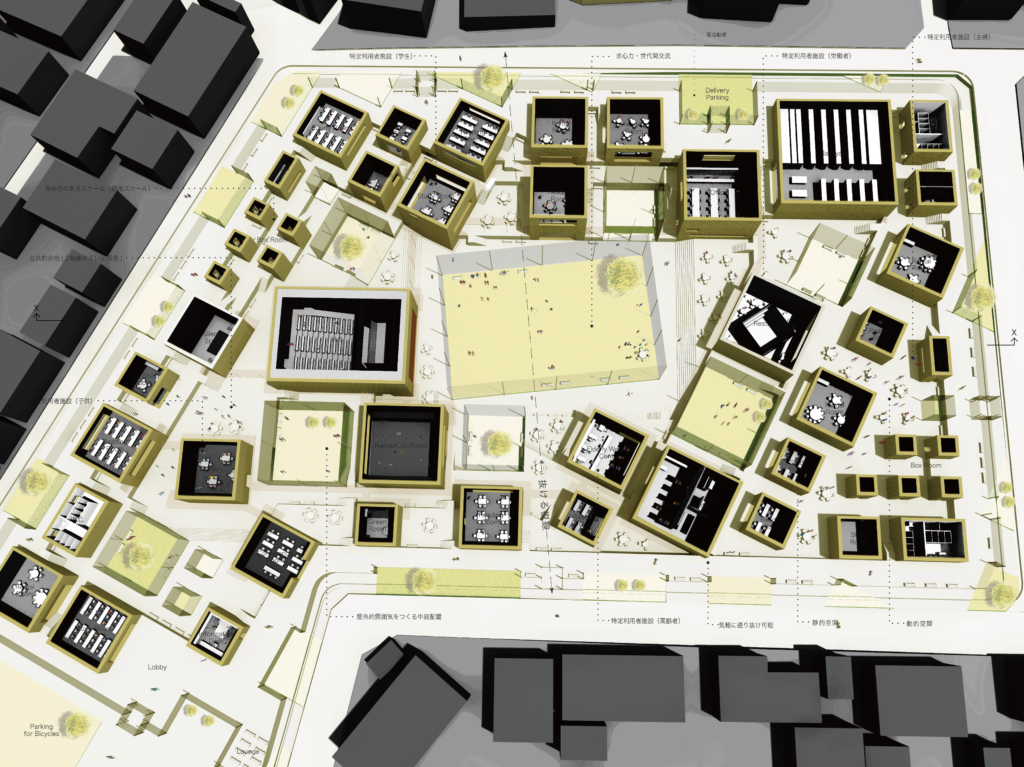

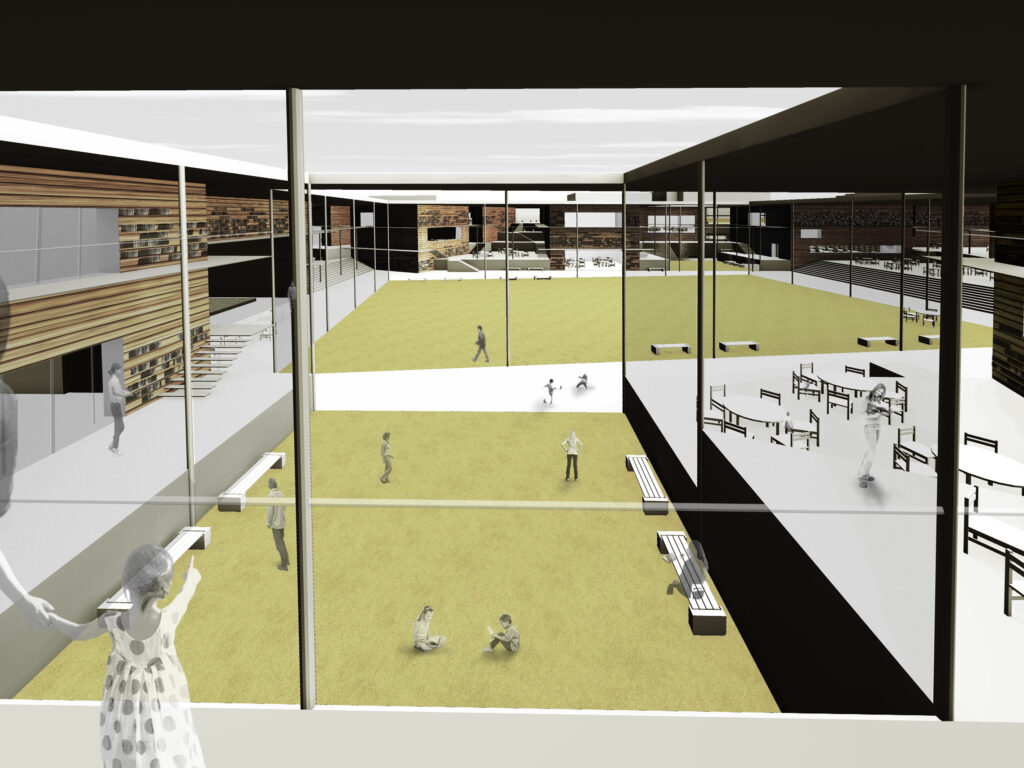
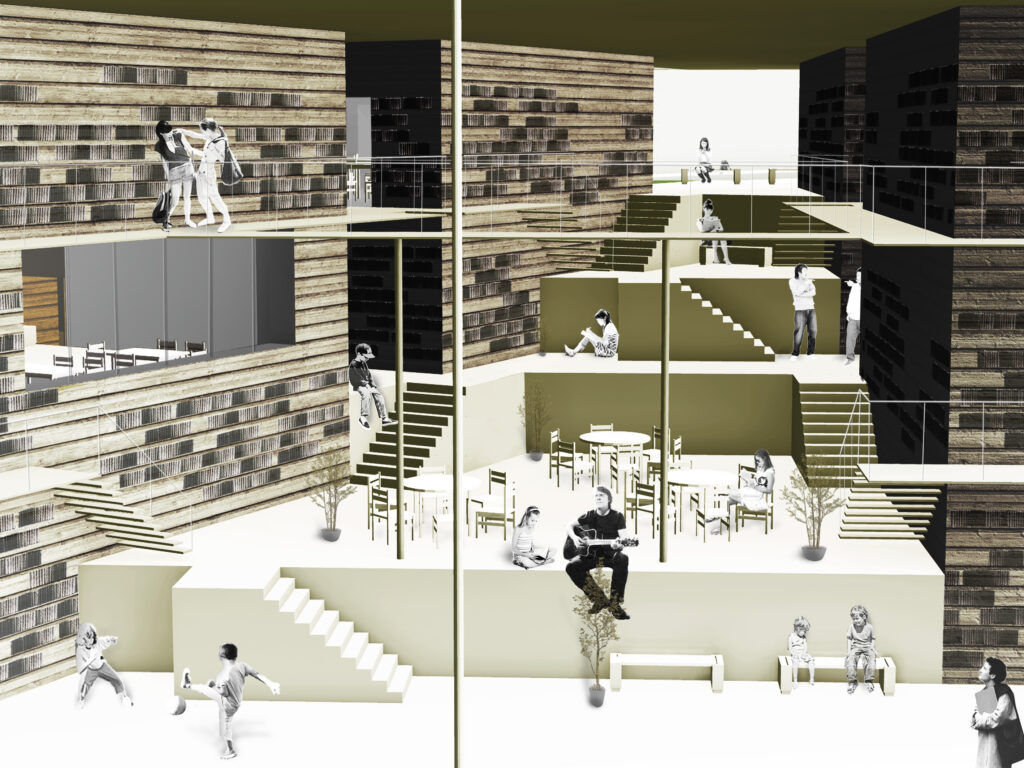
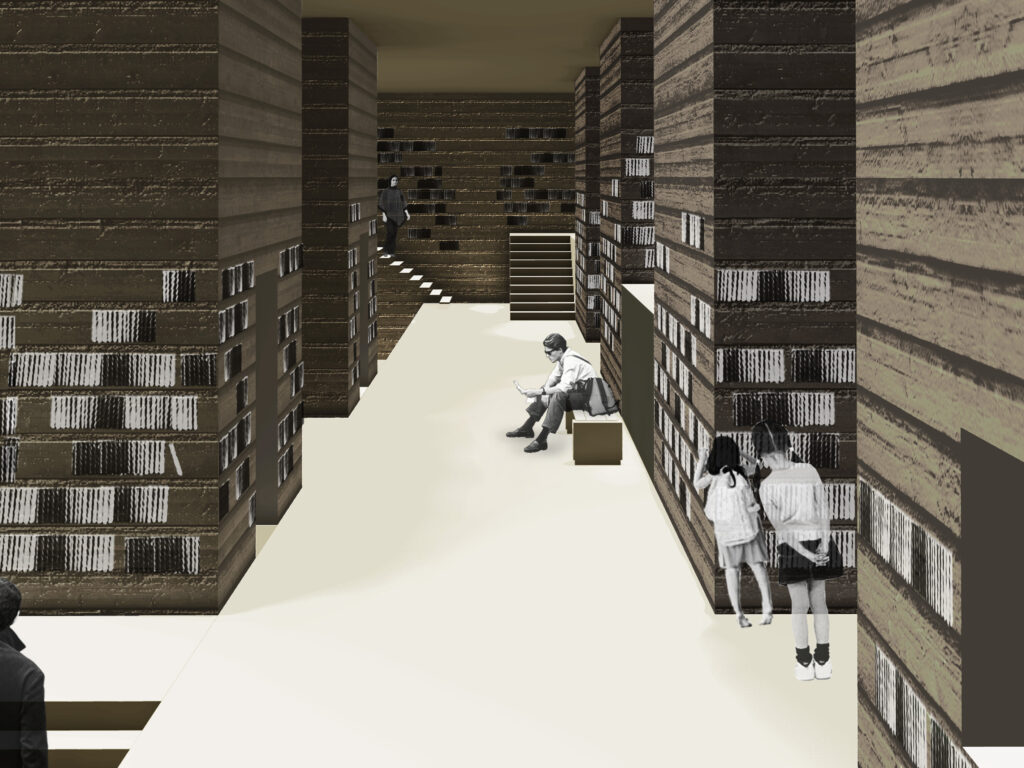
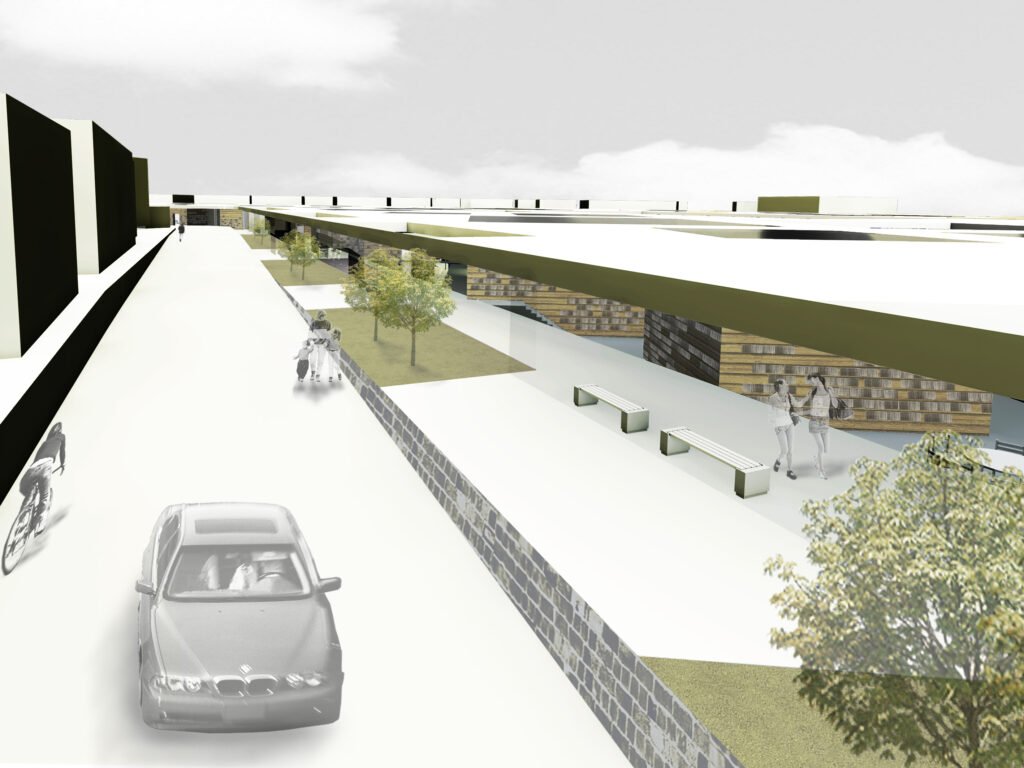
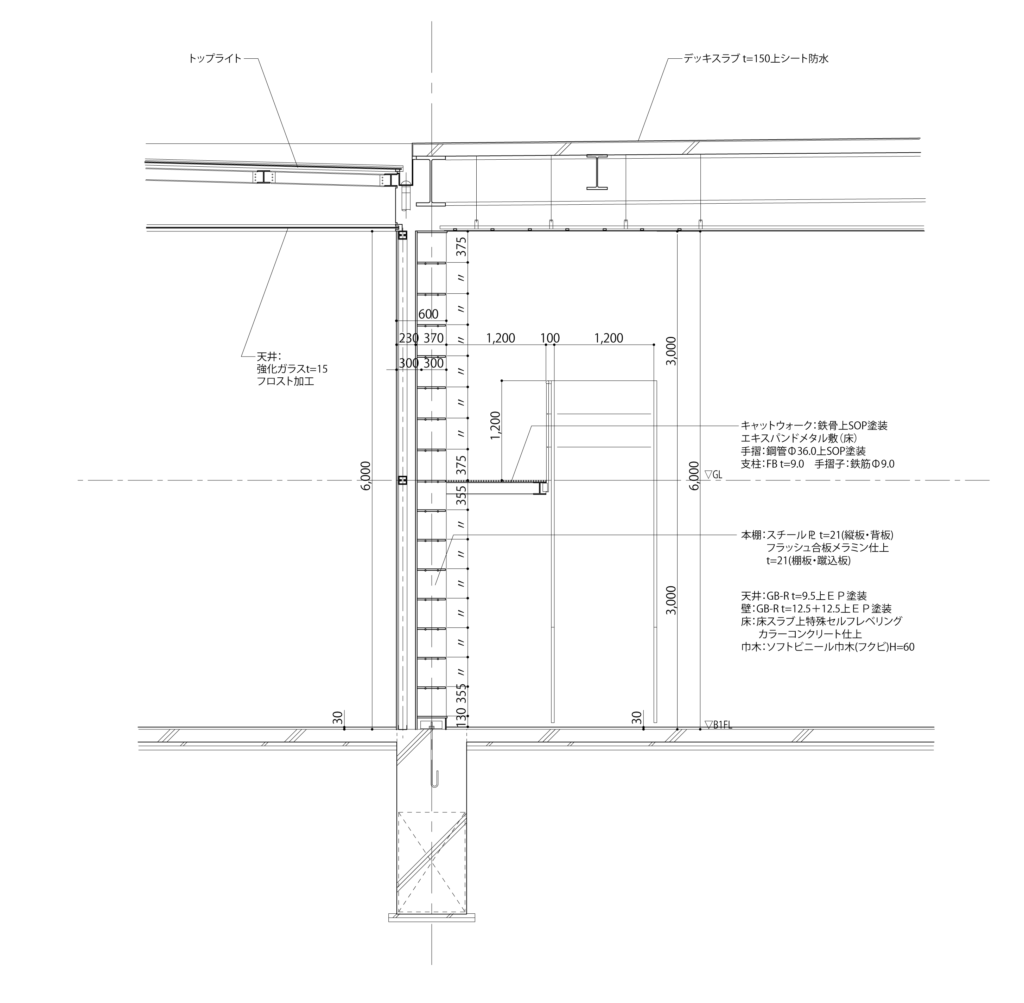
まちの中の書架空間
(English Below)
敷地は千葉市内、高台にある住宅街の中心に位置する。周辺には公的機関やショッピング施設、文化施設などが集まり、近くに大きな公園や主要駅があるため、多くの人が生活拠点としているエリアだ。これは、人口が一際多い地域の住宅が密集しているエリアにおいて、人と情報、人と人をつなぐ、地域の教育・文化拠点として機能する公共図書館の、新しい在り方を探った計画である。
図書館は、地域の中核を担う施設のひとつだが、その機能と構成についてあらためて考えるきっかけとなったのが、電子書籍の現出だった。「電子書籍元年」とよばれた2010年は、日本において電子書籍に関わる市場が活況を呈し、その影響は図書館サービスにも及んだ。電子化の進行による本の減退が懸念される中、本の役割を見いだそうとする動きがでてきたことから、本が地域交流の媒体となる書架空間「URA-ROJI」を図書館内に設けることを提案した。
「URA-ROJI」を計画するうえで、静的な室内空間から動的な外の空間へと書架を反転させ、書架が表出したボリューム間のインフラスペースが日常の活動空間と連続するように、まちのコンテクストを踏襲して室ボリュームを配置することを試みた。
まず、室ボリュームについては、周辺住宅の多くが平面9m角、最高高さ9m程度のサイズであるため、そのサイズを基準として設定した。9m角の住宅スケールの部屋を主とし、その他の多くの部屋を6m角や3m角のより人間スケールに近い大きさとした。天井高を3、6、9mとし、一般的な施設の天井高以上を確保しつつ、最大でも住宅のスケールとすることで、施設全体が親しみのある住宅地の延長の場所として感じられるよう計画した。
室配置については、周辺環境から読みとった二方向の軸線を頼りに、アプローチを必要とする場所には周辺環境と軸線をそろえ、配置に連続性をもたせることでアプローチ性を高めているが、中心に向かうにつれ軸線がぶつかるポイントが増えるように配置することで、アプローチ性が低くなると同時に入り組んだ「裏路地」的空間が生まれる。室のボリュームと配置を綿密に調整することによって、本をとおしてコミュニケーションのきっかけができる、まち中の活動的な書架空間をつくりだした。
まちに対する空間戦略においては、高台にあるという敷地の特徴をいかし、敷地の中心部に向かって床レベルが下がる構成にすることで、「求心力のある場を備えた公共施設」という、まちの中での立ち位置を打ち出した。
まち単位や地形単位のコンテクストを読み込みながらデザインすることで、建物内部に地形スケールに近く、人のコミュニケーションを誘発するような、自然地形的魅力を宿した書架空間「URA-ROJI」が生まれた。まちの延長空間に置かれた本を介して地域交流を活性化させる、そんな図書館があってもいいのではないだろうか。
・
・
Bookshelves in a Town
The site is located in the center of a residential area on high ground in Chiba City. Public institutions, shopping facilities, and cultural facilities are concentrated in the surrounding area, and with a large park and a major train station nearby, the area is a living base for many people. This plan explores a new way for the public library to function as an educational and cultural center for the community, connecting people to information and people to people in a densely populated residential area.
Libraries are one of the facilities that play a central role in the community, and the emergence of e-books has triggered renewed consideration of their function and structure. The year 2010, dubbed “the first year of e-books,” saw the e-book market booming in Japan, and its impact was felt in library services as well. Amid fears of a decline in the number of books due to the increasing use of electronic books, there was a movement to discover the role of books, and we proposed the creation of “URA-ROJI,” a space in the library where books can serve as a medium for community exchange.
In planning “URA-ROJI,” we attempted to invert the bookshelves from a static interior space to a dynamic exterior space, and to arrange the room volume following the context of the town so that the infrastructure space between the volumes where the bookshelves appear is continuous with the daily activity space.
First, we set the room volume based on the size of the surrounding residential buildings which are mostly 9m square in plan and have a maximum height of 9m. 9m square residential scale rooms are the main size, while many other rooms are 6m square or 3m square, which are closer to human scale. Ceiling heights of 3, 6, and 9 meters were planned to ensure that the ceiling height is higher than that of a typical facility, but at maximum the scale of a house, so that the entire facility will feel like an extension of a familiar residential area.
As for the arrangement of the rooms, relying on axes in two directions read from the surrounding environment, we arranged the rooms in such a way that the axes are aligned with the surrounding environment for places that require an approach, and the approachability is enhanced by providing continuity in the arrangement. Then by arranging the rooms in such a way that the points where axes collide with each other increase as one moves toward the center, the approachability is reduced and at the same time, an intricate “back alley”-like space is created. By carefully adjusting the volume and layout of the rooms, we created a space for active bookshelves throughout the city, where communication can be triggered through books.
In terms of spatial strategy for the town, we took advantage of the site’s location on high ground to create a configuration in which the floor level lowers toward the center of the site, thereby establishing its position in the town as a “public facility with a centripetal force”.
By reading the context of town and topographical unit to design, we created “URA-ROJI,” a book stack space inside the building that is close to the topographical scale and has a natural topographical charm that induces human communication. It would be great to have such a library that activates local interaction through books placed in the extended space of the town.
